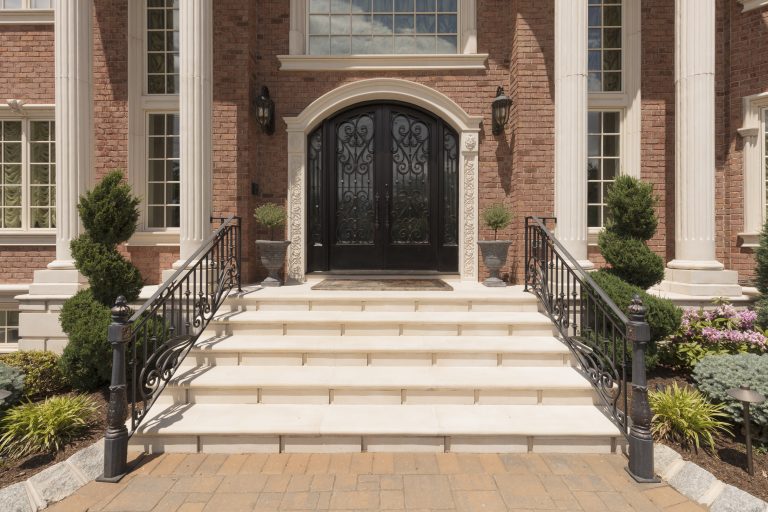Metal railings are synonymous with their durability and security features. They provide long-lasting use and require minimal maintenance. Wrought iron railings, in particular, have become a symbol of ornamental mastery, and a subject of artistic expression and luxury.
Today interior and exterior railings still carry their centuries-old elegance and invoke admiration for both their ever-green styles and resilience. And many modern iron craftsmen have mastered the ability to replicate the transcendent beauty of these metal railings.
Their goal?
To bring the most striking iron design styles back to life, and create the opulent feeling of royal abundance in every home.
Which are the most influential metal railings design styles? Let’s find out.
Mudejar Metal Railings

Metal railings first gained prominence in the 15th century, when Spanish church officials started using metal pieces to fence temples. Back then metalworks carried a religious and symbolic meaning. Ornate iron window grills, frames, and railings were used to inspire the congregation and incite respect and fear in those with impure thoughts.
The Moorish masters were known and respected for their ability to bend the metal to their will, creating twisted square rods, and coiling flat bars into C-shaped scrolls of all sizes. They were the craftsmen who turned metal forging into actual art.
They came up with imaginative crestings to surmount the top of church chapel screens or domestic window grilles, blending Gothic with Moorish designs that resulted in the Mudejar style.
The Mudejar style is characterized by elaborate geometric designs with which the masters tried to relay a sense of wonder but also lavishness of material and ornaments.
To bring their iron creations to life the masters would employ complicated patterns. And as the Mudejar style came from the Muslim culture of Al- Andalus ( modern-day Spain and Portugal) leaning towards vegetal designs instead of figural images was a distinctive characteristic.
Baroque Metal Railings

King Louis the XIV, of France, was the benefactor of the Braque metal railings style of the 16th century. Ironworks created in the style were ornate with plentiful scrollings and bold foliations that were meant to impress and create an esteemed sense of abundance and riches.
Baroque railings incorporate details that create a feeling of motion, with handmaid circular elements and scrolling embossing the railings. Designed to mimic vines and flowers, these railings brought nature into royal palaces and noble houses.
Georgian Metal Railings

The 18th century marked the introduction of the Georgian metal works style. Thanks to the adoption of cast iron and the simplified metal production processes railings could be created with similar intricacy and attention to detail, but from much cheaper, although not as durable material- cast iron.
Encouraged by the British monarchs at that time, the style was known for its symmetry and precise proportions. The Golden ratio influenced the decisions of ironmasters and emphasized the importance of harmony and uniformity in every architectural piece.
Metal railings from that period feature simple designs with square or round railing bars topped with spiked heads.
Rococo Metal Railings

Next in the 19th century, came the Rococo design style that stressed the beauty of asymmetry and heavily influenced how wrought iron railings were shaped.
Rococo metal railings came with elaborate ornamentation that used curved and serpentine lines to present a playful twist on previous forging styles. They depicted themes like love and myths with a youthful and feminine touch.
Victorian Metal Railings

Another distinct metal design style that was reviewed in the 19th-century Victorian era was the Gothic style. It was during the Victorian era that this style began to dominate domestic and public architecture with various gothic railings created and installed around Britain.
The Gothic railings contrasted with other classical styles with their harsh and straightforward lines, meticulously forged and imposing. A diversity of spires and gargoyles are often present in ironworks from that period. Various railings incorporate twisted railing bars, rosettes, and ostentatious railing heads.
Edwardian Metal Railings

The beginning of the 20th century was marked by new influences on metalwork design. Edwardian architects and iron masters blended elements of the uniformity of the Georgian period and the sharp Gothic elements and created iron railings with ornate elements. Plain round railing bars with decorative heads or the use of occasional infill panels were the norm.
The naturalistic elements of the Arts and Crafts Movement and the organic curves of Art Nouveau prevailed in every aspect of architecture- metal railings included. The Art Nouveau style was characterized by flowing “moving” lines, motives, and patterns that felt organic. Iron craftsmen created the now-famous “whiplash” motifs, formed by dynamic, wavy, and sleek lines in a rhythmic pattern.
On a Closing Note
From the beginning of their existence metal railings carried the duality of being functional architectural features along with objects of artistic and symbolic expression. Countless ironmaster’s devotion in establishing the craft and creating a legacy of intricate ironwork designs left us with immeasurable treasures. And now we get to enjoy a rich variety of styles and techniques in the craft of metal railings forging. These 6 design styles have helped us better understand our craft and we’re happy to share that legacy with you too.



